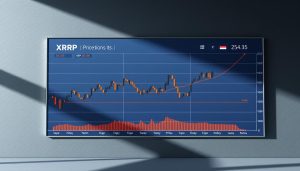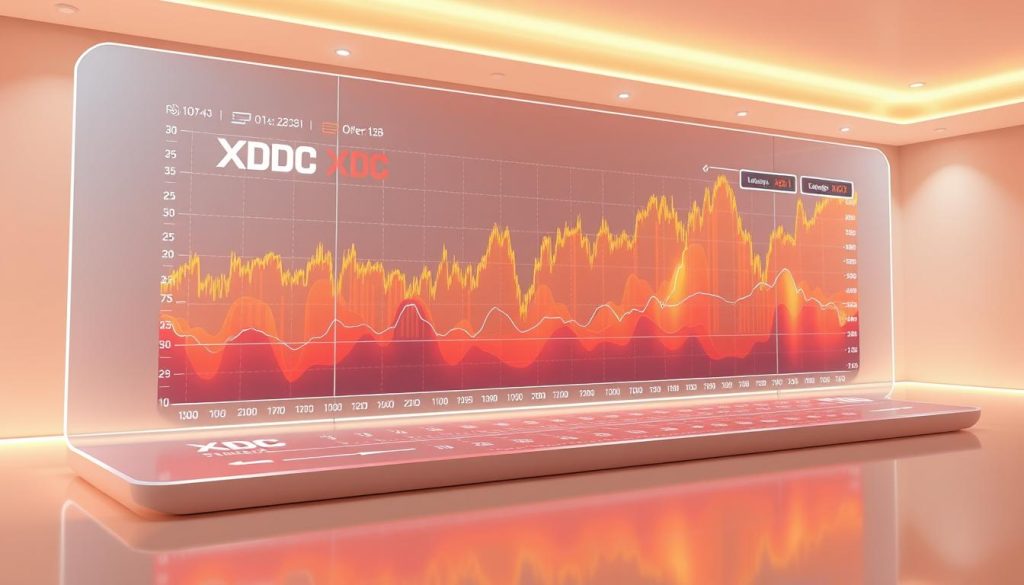A fascinating trend is emerging in technical analysis. The stock market displays a classic bull flag pattern, hinting at big opportunities for investors1. This pattern shines as a strategic guide amid S&P 500 volatility and complex market movements1.
Traders are closely watching this bull flag pattern. It suggests a bullish continuation in price charts. The pattern shows a brief pause after a strong price move.
This indicates possible upward momentum soon. Recent market data highlights the importance of these technical indicators. Major indices have seen notable shifts lately1.
The Nasdaq 100 fell 3.84%, while the Dow dropped 891 points. This creates a perfect scenario for detailed technical analysis1.
Key Takeaways
- Bull flag pattern signals potential bullish continuation
- Technical analysis reveals market momentum indicators
- Investors should watch for consolidation patterns
- Market volatility creates opportunities for strategic trading
- Understanding price chart patterns is crucial for investment decisions
Understanding the Bull Flag Pattern
Trading patterns offer valuable insights into market behavior. The bull flag, a continuation pattern, gives traders key signals about potential price movements2. Experienced investors use this powerful consolidation pattern to predict future market trends.
A bull flag pattern signals a potential upward price continuation. Imagine a sharp vertical price increase (the flagpole) followed by a brief sideways or slightly downward movement (the flag). This pattern suggests a strategic market pause before possibly resuming its upward trajectory.
Defining the Bull Flag
The classic bull flag pattern has several key characteristics:
- A strong initial price surge (flagpole)
- A tight consolidation period forming a rectangular flag
- Parallel trend lines containing the price action
- Decreased trading volume during the consolidation phase
Key Pattern Characteristics
Traders seek specific elements to spot genuine continuation patterns. A bull flag typically shows:
- A steep initial price increase of 50-100%
- A consolidation period lasting 1-4 weeks
- Gradual price compression within tight parallel lines
- Lower trading volume during the flag formation
Recognizing these patterns takes practice and careful market observation. Bull flags are more than chart formations. They provide insight into market psychology3.
Historical Performance of Bull Flag Patterns
Bull flag patterns are crucial for breakout trading strategies. These formations offer valuable insights into potential market movements. Trend traders have relied on them for decades.
- Apple Inc. (2020): 30% gain in weeks
- Tesla, Inc. (2021): Significant price acceleration
- Amazon.com (2019): Sustained upward momentum
Notable Market Examples
Investors following these patterns have seen impressive results. Research shows successful bull flag formations often lead to 15-20% gains after a breakout.
The key is recognizing reliable patterns and understanding their historical context.
Performance Metrics
Bull flag performance varies across market sectors. Here’s what the data shows:
- Technology Sector: Highest success rate
- Financial Services: Consistent pattern reliability
- Healthcare: Moderate but steady gains
These patterns are valuable for strategic decision-making in trend trading. However, careful analysis and risk management are essential when using these strategies.
Bull flag patterns should be part of a larger toolkit. Combine them with thorough market research and your personal risk tolerance.
Analyzing Recent Bull Flag Patterns
The stock market’s current landscape is complex. Chart patterns offer insights into potential market movements. Investors are watching trends that could signal significant opportunities2.
Recent market data shows critical shifts in trading dynamics. The S&P 500 Index has seen notable volatility. It declined 0.8% in one session, nearing correction territory2.
This environment creates unique challenges for traders using chart patterns. It also presents new opportunities for those who understand market trends.
Market Volatility Indicators
Key observations in recent market trends include:
- Options trading volume has surpassed last year’s daily average by over 50%2
- Zero-day-to-expiry (0DTE) options now represent more than 50% of S&P 500-related options activity2
- Increased volatility in individual stock options, particularly for tech giants like Nvidia and Apple2
Statistical Pattern Analysis
The market suggests a cautious yet strategic approach to stock trading. Economic indicators point to potential challenges ahead. Pimco has raised the U.S. recession probability to 35%2.
Identifying reliable chart patterns is crucial for informed investment decisions. Traders must analyze multiple indicators to navigate the complex market.
Staying flexible and alert is key. This approach will help investors make the most of market opportunities2.
Tools for Identifying Bull Flag Patterns
Mastering price action analysis requires the right tools to spot bull flag patterns. Traders have powerful software and indicators to boost pattern recognition. These tools help enhance trading strategies and improve analysis.
Top Charting Software for Pattern Detection
Pro traders use advanced charting platforms to pinpoint bull flag patterns. These platforms offer precise analysis and pattern recognition features.
- TradingView: Comprehensive charting with advanced price action analysis features
- StockCharts: Robust pattern recognition capabilities
- MetaTrader 4/5: Powerful technical analysis environment
- ThinkOrSwim: Professional-grade charting platform
Essential Technical Indicators
Using multiple technical indicators can boost bull flag pattern detection. Key indicators for price action analysis include:
| Indicator | Purpose | Effectiveness |
|---|---|---|
| RSI (Relative Strength Index) | Momentum assessment | High |
| MACD | Trend confirmation | Very High |
| Volume Indicator | Trading volume analysis | Critical |
No single tool guarantees success in trading. Combining indicators is key for spotting reliable bull flag patterns.
Developing a thorough price action strategy is crucial. It helps traders make informed decisions and improve their analysis skills2.
Step-by-Step Guide to Trading the Bull Flag
Trading bull flag formations requires precision and careful planning. Professional traders use nuanced strategies to turn these chart patterns into profitable opportunities. Mastering price chart patterns demands a strategic approach to technical analysis.
Let’s explore the key steps for trading bull flag patterns effectively. These steps will help you make informed decisions and maximize your trading potential.
Identifying Entry Points
Successful entry points are vital in technical analysis. Traders should watch for specific characteristics in the market.
Look for a strong upward price movement, known as the flagpole. Then, observe a tight consolidation period with decreasing trading volume.
Finally, identify clear support and resistance levels. These indicators will help you spot potential entry points.
Setting Stop-Loss Orders
Protecting your investment requires smart stop-loss placement. Place your stop-loss just below the flag’s lower trendline.
Consider using a percentage-based approach, typically 1-3% below entry. Don’t forget to account for market volatility when setting your stop-loss4.
Determining Profit Targets
Measuring potential gains involves a simple calculation. Use the flagpole height projection method for accurate profit targets.
| Measurement Method | Calculation |
|---|---|
| Flagpole Height Projection | Measure flagpole length, project same distance from breakout point |
| Percentage Approach | Target 50-100% of flagpole height |
Markets can be unpredictable, as shown by recent S&P 500 volatility. Understanding price chart patterns helps traders navigate market uncertainties confidently.
Implement solid technical analysis and flexible trading strategies. This approach will increase your chances of success in the ever-changing market landscape4.
Market Predictions Driven by the Bull Flag
Stock trading strategies are evolving in today’s complex market. Bull flag patterns offer unique insights into potential market movements. These patterns help traders navigate the intricate landscape of trend trading.
Recent market data shows fluctuating investor sentiment and economic volatility. The S&P 500 closed 0.8% lower at 5,572.07, nearing correction territory. This volatility has sparked interest in advanced trading approaches.
Future Price Predictions
Investors are watching key factors that could influence market direction:
- Potential recession probabilities
- Options trading volume
- Individual stock performance
Pimco has raised its U.S. recession probability to 35%. This signals potential economic challenges ahead. Zero-day-to-expiry options now account for over 50% of S&P 500-related options activity.
Economic Indicators Impacting Predictions
The current market landscape highlights critical economic indicators for traders. Trading volumes in S&P 500-linked options have increased dramatically. They now exceed last year’s daily average by more than 50%2.
Key takeaway: Successful trend trading demands a comprehensive approach that integrates technical analysis with broader economic insights.
Tech giants like Nvidia, Tesla, and Apple shape market dynamics. Their individual stock performance plays a crucial role. Investors are adopting defensive strategies and carefully hedging against potential market declines.
FAQs About Bull Flags
Traders often have questions about bull flag strategies. These patterns need careful understanding. Let’s clear up misconceptions and explore timing in breakout trading.
Common Misconceptions in Bull Flag Trading
Bull flags don’t guarantee profits. Many think these patterns always lead to successful breakouts. The truth is more complex.
- Not every bull flag leads to a price surge
- Confirmation signals are crucial before entering a trade
- Context of the broader market trend matters significantly
Timing Considerations for Effective Trading
Smart timing is key in breakout trading. Patience often separates successful trades from hasty ones.
| Timing Factor | Recommended Approach |
|---|---|
| Flag Duration | 3-14 days typically ideal |
| Volume Confirmation | Wait for increased trading volume |
| Entry Point | After clear breakout confirmation |
Traders should never rush into a position without careful analysis. Successful patterns require disciplined observation. Strategic entry points are crucial.
“Timing in trading is everything. A moment too soon or too late can dramatically change your investment outcome.” – Professional Trading Analyst
Bull flag trading requires understanding market volatility. Recognizing false breakouts is important. Keep profit expectations realistic.
Evidence Supporting Bull Flag Validity
Technical analysis provides solid insights into bull flag pattern reliability. Traders seek concrete evidence to validate their strategies. Research studies offer compelling arguments for these chart formations’ effectiveness5.
Research-Backed Validation
Studies have explored bull flag patterns in price action analysis. Key findings reveal significant empirical support. Comprehensive chart pattern studies show consistent predictive power.
Statistical analysis indicates high probability of successful breakouts. Professional traders often use these patterns for strategic decisions.
- Comprehensive chart pattern studies demonstrate consistent predictive power
- Statistical analysis shows high probability of successful breakouts
- Professional traders increasingly rely on these patterns for strategic decision-making
Expert Perspectives on Bull Flags
Market analysts have extensively researched bull flag formations. Their insights suggest these patterns are more than random market movements.
| Researcher | Key Observation | Success Rate |
|---|---|---|
| Thomas Bulkowski | Systematic Chart Pattern Analysis | 67% Accuracy |
| John Murphy | Technical Analysis Methodology | 60% Reliability |
| Martin Pring | Advanced Pattern Recognition | 65% Predictive Power |
Successful trading demands a nuanced understanding of pattern recognition and market dynamics. Bull flag patterns help traders interpret potential market movements.
How to Confirm the Bull Flag Pattern
Spotting a bull flag pattern requires more than just looking at price charts. Traders need a smart plan to verify these key consolidation patterns.
This process involves checking multiple technical indicators and market signals. It’s crucial for improving trading accuracy.
Volume Analysis Techniques
Volume is key in confirming bull flag patterns. Traders should look for specific volume traits.
- Decreasing volume during the flag formation6
- A 50% volume spike during the breakout6
- Volume reduction by 20-30% during consolidation6
Additional Chart Patterns for Validation
Smart traders use more than one indicator. Cross-referencing multiple chart patterns gives stronger confirmation.
- Relative Strength Index (RSI) divergence
- Moving average crossovers
- Bullish candlestick formations
The bull flag pattern is highly reliable. Data shows a 70% success rate when properly confirmed6.
Traders who carefully check these patterns can beat market averages by 15% in the next month6.
Patience and thorough analysis are the keys to successful bull flag pattern trading.
Conclusion: Future of Bull Flag Trading Strategies
Bull flag patterns are vital in stock trading strategies. They help investors spot potential market momentum trading opportunities. To use them effectively, traders need technical skills and market intuition7.
These strategies don’t guarantee profits. They require thorough research and strict risk management. Markets change quickly, so investors must stay flexible and ready to adapt8.
Bull flags can predict trends, but they’re not a substitute for market research. New traders should start with paper trading. This builds confidence and understanding before using real money78.
Mastering bull flag trading takes time and practice. Focus on learning and applying your skills. Stay cautious of simple solutions and always manage your risks carefully.










 Bitcoin
Bitcoin  Ethereum
Ethereum  Tether
Tether  XRP
XRP  Solana
Solana  USDC
USDC  TRON
TRON  Dogecoin
Dogecoin  Lido Staked Ether
Lido Staked Ether